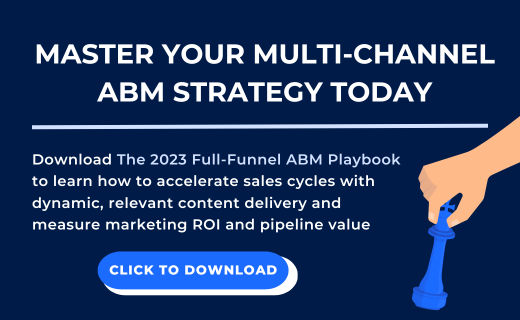
Using Digital Channels with Precision: Mastering Multi-Channel ABM

Multiple decision-makers on a purchasing team do their own online solution research when buying a complex B2B solution. Gartner research suggests sales reps only have 5% of a buyer’s time during their B2B buying journey, so it’s up to marketers to arm buying groups with all the information needed to make an informed decision.
Enter multi-channel account-based marketing (ABM).
Multi-channel ABM helps you meet buying committee members where they are with a persistent and cohesive experience. Why? Because B2B buyers research solutions on various channels and their journey isn’t confined to one place. You can’t dictate where they research and explore solutions. Time and attention rates are a premium, and buyers will no longer waste time looking for the right information. They want to be targeted with the material they need through more personalized experiences that speak to their needs and pain points.
When developing a multi-channel ABM strategy and the content and messaging to use within it, get into the buyer’s mindset by viewing the B2B buyer’s journey as a structured, three-phase expedition:
- Problem Identification: I have a problem; what happens if I don’t solve it?
- Envisioning a Solution: I need to solve this problem. How do I solve it?
- Confidence in Solution: Who is the best choice to help me solve this problem?
Thinking of the buying journey in these three phases shows you deeply understand them and the nuanced requirements accompanying their buying decision. The goal is not merely to provide information but to deliver it in a persistent and customized manner that surrounds the buying committee with what they need. Do this, and you’ll accelerate the buying journey, build that valuable buyer trust, and convert them into customers faster.
Are you ready to dive in? In the first part of our “Using Digital Marketing Channels with Precision” blog series, we’ll highlight what multi-channel ABM really is, the channels to include in your unified strategy, and how to master your approach.
What is Multi-Channel ABM?
Multi-channel ABM engages target accounts with a unified content and messaging strategy across the most frequently used digital channels. Put simply, it’s the best approach in providing that personalized and cohesive experience that helps your brand stand out from competitors and stay top-of-mind throughout the buying journey.
A consistent and personalized experience across all touch points enhances brand credibility and builds trust. Your content becomes a guide for your buyers, and you deliver the same messaging and value propositions across each channel.
Which Channels to Include in Your ABM Strategy?
To maintain consistency and personalize the experience, execute a unified content strategy across the primary channels buyers engage with:
- Content Syndication: When used in a unified multi-channel account-based strategy, content syndication allows you to reach a larger and more diverse audience, increasing brand visibility by engaging prospective buyers and new readers to convert into potential leads for your pipeline.
- Display Advertising: Display advertising often feels more like a necessary evil, but when used as part of a comprehensive data-driven, multi-channel ABM strategy, it plays a critical role in reinforcing key messaging and delivering content to target accounts. It’s a proven method for generating higher clickthrough rates, web engagement, and pipeline.
- Social Advertising, especially on LinkedIn: LinkedIn is the most influential social channel for B2B buyers, and when used as part of a comprehensive, data-driven multi-channel ABM strategy, it enables the delivery of personalized content and messaging to the target audiences and personas marketers need to reach.
- Emerging Channels like Connected TV (CTV) Advertising: Staying ahead of the curve in a rapidly evolving digital landscape involves using emerging channels like CTV in a multi-channel ABM strategy. As more buyers work from home and utilize digital channels for a self-driven buying experience, Connected TV (CTV)—which includes Smart TV’s and other devices that allow brands to reach their audiences through internet targeting—helps surround key decision-makers with content and messaging.
Common Multi-Channel Pitfalls (And How to Avoid Them)
Like any great strategy, multi-channel ABM has its fair share of challenges. Here are some common pitfalls that can derail your efforts and waste your time and resources:
- Indeterminate Business Goals: Approaching multi-channel campaigns without a clear business goal aligned to your strategy leaves you aimlessly targeting buyers and creating content without a purpose. Your messaging and strategy will change depending on your goals. We’ll supply examples in the next section.
- Resource Intensity: Multi-channel ABM demands resources, so a well-thought-out plan is vital before diving in. No plan can leave you with little results to show and an overused budget.
- Misalignment with Internal Teams: Collaboration is key. Marketing, product, sales, customer success – everyone needs to be on the same page to give buyers that personalized and unified experience.
- Underutilization of Data: In ABM, data reigns supreme. It’s not just for identifying accounts; it’s the secret sauce for creating personalized experiences and measuring campaign effectiveness.
- Poor Management of Data: Data silos can hurt you before you start. Research supports using multiple sources to validate assumptions, identify buying group members, and map out the buying cycle stages. But without unifying data by deconstructing data silos, you hinder your campaign success and the buyer’s experience.
Avoid these pitfalls by leveraging a pilot campaign that helps you crawl before you walk and run. This best practice lets you test the waters, gain insights, identify these and other common mistakes, and ensures all your teams have the necessary resources to succeed. Think of it as a strategic trial run before launching a full-scale ABM campaign.
Mastering a Multi-Channel ABM Strategy
Executing successful multi-channel ABM requires you to align your strategy with the buyer’s mindset and the buying journey. Let’s break down the steps to help you navigate your strategy.
Step 1: Determine Your Goals
No campaign can be successful without first establishing goals to serve as a guiding light for all your decisions and activities. Goals to consider for your multi-channel ABM strategy include:
- Brand Awareness
- New Account Acquisition
- Opportunity Creation
- Pipeline Progression
- Customer Retention & Expansion
Whatever your goal, it must be aligned with other internal team goals. Defining common goals with your sales and customer success teams will help in maintaining that consistent customer experience and ensuring that everyone is working towards the same objective.
Step 2: Align Channels with Goals and Buying Journey Stages
With your goals set, align your chosen digital channels with your specific objectives and the stages of the buying journey. Here are three examples:
- Awareness among New Accounts (Top of Funnel): Utilize social media, email, blog posts, display ads, and even CTV ads to provide relevant and educational content that draws eyes to your brand.
- Drive More Engagement with Existing Known Accounts (Middle of Funnel): Consider content syndication for webinars, white papers, and eBooks to deepen engagement and trust in your solution.
- Accelerate Qualified Opportunities (Bottom of Funnel): Employ display advertising, social advertising, and last-mile content such as product sheets, case studies, and comparison guides to move prospects closer to conversion.
Step 3: Activate the Same Target Account List Across All Channels (Cross-Channel Activation)
Cross-channel activation of your target account list maximizes your reach and investment. B2B purchases are a team sport, not a solo exercise. Influencing a buying committee of six to 10 members requires anywhere from 15 to 20 touches per decision-maker, which can multiply to 200 touches per account! A tall order like this means you must intentionally target the personas on every channel, using the same target account list to make that lasting impression.
By surrounding the buying committee with personalized, relevant content, you keep your brand and solution top-of-mind, a critical factor considering research reveals that many buying groups make their decisions based on an initial top choices list crafted on day one.
Step 4: Measure Account Engagement and Pipeline Impact
Determine Key Performance Indicators (KPIs) for your multi-channel ABM campaign based on your objectives and business goals. Then, use the tools available like ABM platforms for measuring account engagement and pipeline metrics to discover campaign insights and ROI. For example:
- Awareness Among New Accounts: Track metrics like content downloads, impressions, social media engagement, and views. Pipeline metrics might include the volume of new accounts won and new opportunities.
- Drive More Engagement with Existing Accounts: Monitor engagement metrics such as downloads, page visits, social media engagement, and email responses. Pipeline metrics could encompass increasing deal sizes/value and identifying account expansion opportunities.
- Accelerate Qualified Opportunities: Focus on engagement metrics like content downloads, email open rates, impressions, and website visits. Pipeline metrics may involve pipeline velocity, conversion rates, and sales cycle length.
This is another area where stakeholder alignment is key. A consistent dialogue between cross-functional teams and C-level executives keeps all boats rowing in the same direction. This is especially true during challenging times when business, product, service, and team resources must pivot quickly, but also true in the best of times when two-way, open communications between internal teams ensures everyone is working toward the same goals.
Measuring and analyzing shared KPIs is crucial for understanding the effectiveness of your ABM strategies. With regular tracking, these metrics allow all internal teams to identify areas for improvement, adjust their tactics accordingly, and ensure their efforts are aligned and focused on delivering the best possible customer experience. Meet with sales and customer success teams to share data and insights on account engagement and feedback loops on new content strategies. Deliver results to company leadership together to demonstrate the ROI of a multi-channel ABM strategy with the number of marketing-influenced accounts in the pipeline.
Step 5: Continuously Optimize Your Approach
Multi-channel strategies aren’t one-size-fits-all. Ongoing optimization is vital to staying effective. Here are a few reasons why:
- Changing Buying Behaviors: Buying behaviors and activities can evolve, and prospects might get stuck in a particular stage of the buying journey, requiring further engagement and nurturing. You may need to rethink your content strategy and create more re-targeting ads on LinkedIn and extend the promotion of your buying guide, for example.
- Refining Target Account Lists: Your first assumptions about the best group to target may not align with the best buyers for your solution. Maybe you envisioned that healthcare professionals spent a lot of time on LinkedIn, but they respond to emails faster. Continually monitor account activity and intent data to stay relevant.
- External Factors: External forces, like global events or industry shifts, can impact your strategy. For example, a global pandemic might cause a goal shift from acquiring new customers to retaining those at risk of churning.
It’s essential to foster a culture of feedback and continuous improvement. Maintaining an open and honest dialogue that enables your internal teams to learn from each other’s experiences, adapt to new challenges, and deliver a better customer experience. By keeping a keen eye on optimization opportunities, you’ll maximize the effectiveness of your multi-channel ABM strategy and show your buyers that you can meet their needs, no matter the circumstance.
Unify Your Multi-Channel ABM Strategy with Madison Logic
The world of B2B marketing is in a constant state of flux, and as purchase behaviors evolve, it’s paramount that we adapt by meeting buyers where they are and guiding them through the buying journey.
A multi-channel ABM strategy ensures that your target accounts receive a consistent and personalized experience at every interaction. This approach builds brand credibility and promotes deeper engagement.
Next, we’ll delve into how to supercharge your multi-channel ABM strategy with actionable insights and recommendations on executing your content syndication campaigns more effectively.
If you’re eager to explore how Madison Logic empowers a unified multi-channel ABM strategy through our cutting-edge solutions and expert teams, request a demo.
Now that you’ve mastered your multi-channel ABM strategy, take a look at our other resources to help you refine your approach:
- How to Build a Successful Competitive Displacement Campaign
- Now is the Time to Get Real About Creating Demand
- Webinar: Multi-Channel ABM Innovators


